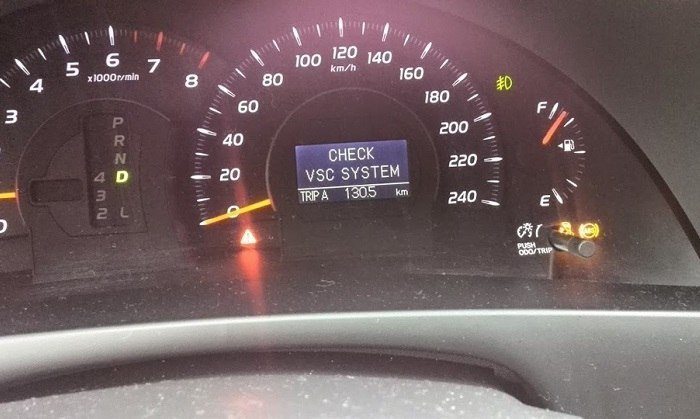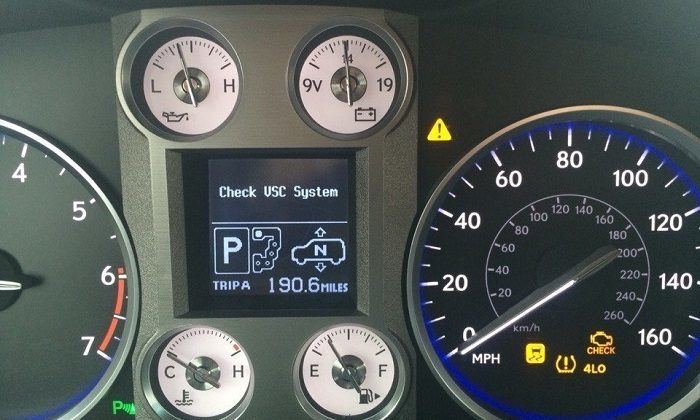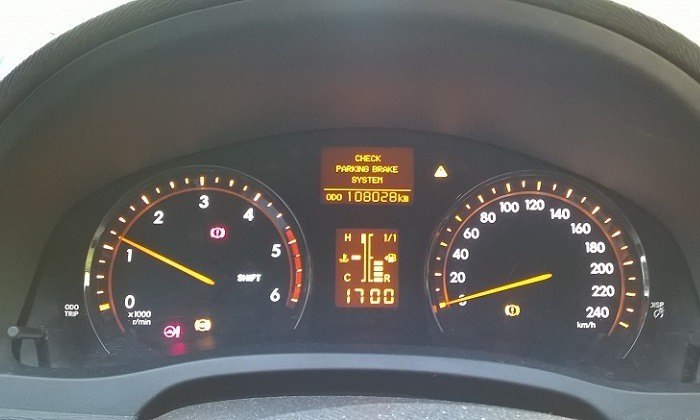by Joshua Thomas
For those that drive in harsh climate conditions a lot, the VSC system is one of the most useful features on their vehicle as it will help ensure the vehicle maintains excellent tractions.
VSC or Vehicle Stability Control is a common feature in many Lexus and Toyota vehicle models, and it kicks in immediately it realizes the vehicle is losing traction to apply brakes to the wheels and prevent further skids.
Hence, when the check VSC system light comes on, there is a reason for concern as it means there might be an issue with the system, and it hence might not be able to control skidding effectively.
Contents

The VSC or Vehicle Stability Control is a state-of-the art technology that can help drivers to control their cars. It does this by detecting the under-steering and over-steering of the vehicle which causes one side to lose grip on the road surface, making turns uncontrollable. The system detects these movements by taking information from the anti-lock brake sensors, steering angle sensor and gyro input.
It can prevent or reduce skidding of the vehicle by braking specific wheels which has lost grip on the road surface. When braking is applied to one side of the car (one of front two wheels) while turning, it will cause under-steer. Under-steer is when the car does not follow the intended path and instead the front of the car wants to pass through where you turn. It can cause loss of control or collision, though some drivers like to slide which may be fun up to a point; we don't want that here.
If on the other hand you get over-steer where the back of the car slides out, this usually happens when you brake mid-turn or turn too fast. The VSC detects this and applies braking to the non slip wheel on your side to bring it under control. This is why most people say that ABS (anti lock brakes system) prevents skidding however in fact both of these systems work in tandem to ensure a safe and controlled stop.
This system is also fitted with a yaw sensor which detects the angle of the car between left and right direction it's going in, this provides vehicle stability information to the control unit which interprets if your wheels are losing grip.
In addition, VSC applies brakes on individual wheel - not on all wheels at once - which enhances driving stability and traction on slippery surfaces. VSC reduces braking distances on dry surfaces, prevents skidding and improves handling of the vehicle. In addition, it helps to reduce fuel consumption as the engine power is distributed more uniformly across the four wheels.
The VSC is an internal traction control system that you can get in popular Toyota vehicles like Toyota Camry and Toyota Sienna and also on Lexus models is250 and is220d and various other Asian vehicle types.
When driving through slippery terrain such as when it is raining or snowing, the system prevents dangerous vehicle skidding.
This system works by applying the brake to all the four wheels or specific wheels according to the skid pattern and also reducing the engine power to make the vehicle easier to control.
Each of the wheels in the vehicle will have a sensor that communicates with the PCM (Powertrain Control Module). These sensors are what will provide information to the control module when the wheels are losing traction by relaying data on their horizontal and vertical motion.
When the check VSC system light goes on, this is a sign that there is an issue with the system, which can either be a problem with the sensors or even the steering rack.
But because the VSC works together with the ABS, when the check VSC light comes on, it can also indicate there is an issue with the latter, and so both may not be functioning properly.
When driving through heavy blizzard conditions, the snow build-up will often interfere with the sensors and hence causing the VSC light to come on. In such a situation, you will only need to allow the snow to thaw and then reset the light with an OBD 2 scanner and the system should be okay.
Physical damage to the sensors in case of an accident may also damage them causing them to stop functioning, and in such instances, the light will also come on.
If the sensors are not feeding information to the PCM due to any other reason besides damage and snow or dirt buildup such as being worn out, the check VSC light will also come on as this is also an indication that things are not working right.

As handy as the VSC system might be, sometimes you might not need it for some driving situations as it can make it hard for you to drive smoothly. In such a situation you might have to use the VSC off button which most vehicles with this system will also include.
Here are some of the situations where you may need to switch off the VSC system.
If you find your vehicle stuck in mud or heavy snow build-up, the best way to get out of this situation, and this is more so if it is the front wheels that are stuck, is by switching off the VSC system.
With the VSC system switched off, it will be easy to rock the vehicle and free it. Remember that the VSC restricts the engine performance and also applies brakes to the wheels.
When stuck, you need to be able to move the vehicle with no restrictions to get out of the situation, and hence the need to switch off the VSC system.
When driving in uneven terrain, you will be better off without the VSC system as you will be in more control of the vehicle with no restrictions to engine power and wheel rotation.
In uneven terrain, you need to be able to change your speed and engine power output at will so that you can tackle different situations, which you are not able to do with the VSC system.
When the VSC picks out unusual resistance between the tires and ground caused by the uneven terrain, it will trigger the system which then reduces the wheel rotational speed and engine power, and hence making it harder to maneuver in this terrain.
Like any other system in your vehicle, the VSC system is also prone to malfunctioning and misbehaving, which means it can be triggered when there is no issue with the driving conditions at all.
When you notice your wheel rotation speed reducing and engine not providing enough power, and you are certain that there is no risk of skidding given the driving conditions, you may have to switch off the VSC system.
A problem with the sensors or control module than manages the VSC might be causing it to be triggered when not needed. Hence, you will be better of switching it off until you have the issue checked and resolved by a professional.
Like any other check light in your vehicle, the check VSC system is a source of concern, and so it is only fair for motorists to want to know whether they can drive with it or not.
To simply state it, whether it is safe to drive with this light on will depend on what caused it to come on in the first place.
If you have checked and determined the source of the light is a faulty O2 sensor, then it is possible to keep driving the vehicle until you have time to get it fixed. However, driving with the light on in such a situation will affect the fuel economy significantly.
Also, if you are not driving in adverse weather conditions, you can drive with the light on for a while before you can have it fixed. Note that the fact that some vehicles do not even have this feature means that it is not crucial for the functioning of the vehicle.
With that said, it is important to have the issue fixed or the light reset the soonest possible for peace of mind and to ensure you drive safely.

In many instances, the check VSC system light will only come on when there is an issue. And so when it comes on, you need to reset it to ensure this vital system continues functioning effectively.
Although a professional mechanic will be the best option for fixing the issue, you can still reset the VSC light on your own in a few easy steps.
Directions
The first step when trying to reset this light will be to park the vehicle in a safe place where you can work from, switch it off and then apply the parking brake to ensure it will not move when working.
Next, pop the hood and then examine the engine compartment to check whether you can identify the issue causing the light to switch on. You should locate the air filter box which should be on the engine's left-hand side.
Once you locate the air filter box, you should then examine all the small vacuum lines coming from it, and check whether any of them are loose or broken. If any of the lines are loose, you need to reconnect and retighten them.
Now you can restart the vehicle and drive it to see if the error clears out. If the light switches off, it means the issue is fixed and if it is still there, the steps below will be very useful.
An OBD scanner is always very useful in identifying and clearing any error codes in the vehicle's computer. And so if the check VSC system light still lingers, you should give it a try.
Using this scanner is also quite straightforward as it is all about hooking up to the respective port which is usually under the driver's side of the dashboard, scanning to display the error codes and then clearing them.
If the OBD 2 scan still does not work, the other alternative to get rid of the check VSC system light is by hard resetting it.
To do this, you should park the vehicle safely and then open the hood. You should then disconnect the battery terminals for at least 10 seconds. Doing this will reset the vehicle's computer, which in turn will switch off the VSC warning light.
The last step is always to take the vehicle for a test drive to check whether the light is gone or not. And if possible, you should drive it in areas where it is likely to experience a little skidding to check whether the VSC system will work well.
If the light is gone and the VSC system is working fine, then the vehicle is okay but if not, the only other alternative is to have it checked by a professional mechanic.
"So you've been hearing a lot about the VSC system and want to know if it's for you? Here's how to check your system."
Important notes:
Due to the design and components within the VSC system, it should be checked for function at least once a year. On average, this is once every 12,000 miles (about twice a year). You should look at your owner's manual to be sure.
An important thing to know is that there are two different kinds of VSC systems in cars today. The most common one is the standard VSC system; this has all of the components described below. Some newer vehicles with the TRACS system will not need a check as often because many of the VSC's functions are more advanced.
On the other hand, if you own a car that is more than 15 years old or has around 150,000+ miles on it, then please read all of the article. The components wear out over time and your car may not be as safe.
The VSC system consists of many components, some are internal (inside the car) and others are external (outside the car). Since this article is about checking your VSC system, only the ones that need to be checked will be listed below. However, remember that you should have a full check done on all of the car's components at least once a year.
The VSC system plays a crucial role in many vehicle models when it comes to traction control, and it is often the difference between skidding around dangerously and driving smoothly in adverse climatic conditions.
When the check VSC light comes on, this typically means there is an issue with the system that needs attention to ensure that it continues functioning optimally.
Luckily resetting the light is quite straightforward as you only need to follow the simple steps highlighted below. But, even as you try to get rid of the check VSC system warning light, it is also important that you fix any underlying issue with the sensors or other components.
Sources
 |
 |
 |
 |

About Joshua Thomas
Joshua Thomas just simply loves cars and willing to work on them whenever there's chance... sometimes for free.
He started CarCareTotal back in 2017 from the advices of total strangers who witnessed his amazing skills in car repairs here and there.
His goal with this creation is to help car owners better learn how to maintain and repair their cars; as such, the site would cover alot of areas: troubleshooting, product recommendations, tips & tricks.
Joshua received Bachelor of Science in Mechanical Engineering at San Diego State University.
Just Car Care